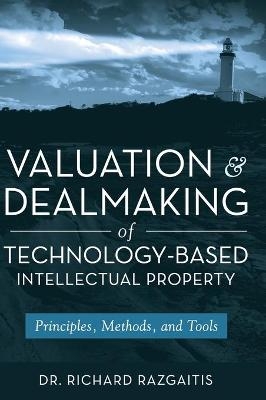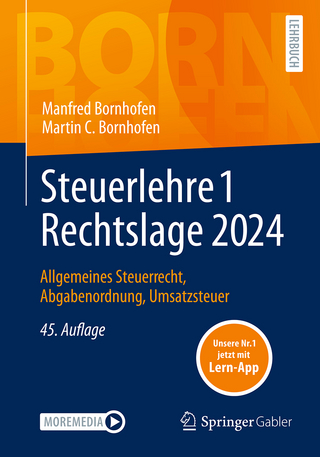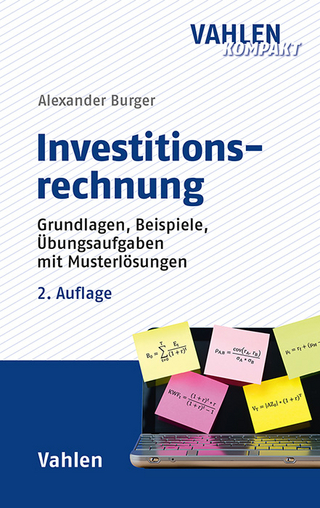
Valuation and Dealmaking of Technology-Based Intellectual Property
John Wiley & Sons Inc (Verlag)
978-0-470-19333-4 (ISBN)
Dr. Richard Razgaitis is a Senior Advisor at CRAI, an international consulting firm providing expertise in economics, finance, and business strategy. He has over thirty years of experience working with the develop-ment, commercialization, and strategic management of technology, more than twenty-five of which have been spent specializing in the commercialization of intellectual property. He has negotiated numerous commercialization agreements with clients in the United States, Europe, and the Far East, ranging from Fortune 500 to small startup companies and is the author of four books on valuation and negotiation/dealmaking published by John Wiley and Sons.
Preface vii
Disclaimer viii
About the Author ix
Acknowledgments xi
Chapter 1 Introduction to Opportunity Discovery, Valuation, and Dealmaking 1
Introduction: Technology D-V-D 1
Taxonomy of Technology Licensing 5
High Significance, High Ambiguity Contexts 7
Licensing D-V-D and Innovation 12
Going Forward 23
Notes 23
Chapter 2 Risk and Reward 27
Uncertainty 27
Phronesis (Judgment) 31
Technology Uncertainty 32
More on Risk 35
Value and Price 45
Two Final Points on Buying and Selling 48
Notes 49
Approach I Opportunity Discovery 51
Chapter 3 Identifying and Prioritizing Technology Opportunities 53
Seller “Opportunity Space” 53
The Technology Box 63
Buy-Side Expressions of Value: The Wheelbarrow 69
Overview of Valuation Methods 71
The Six Valuation Methods 77
Conclusion 81
Notes 82
Approach II Valuation 85
Chapter 4 Method 1: Use of Industry Standards for Valuation 87
The Concept and Limitations of “Industry Standards” 87
Sources of Industry Standard Data and Information 97
Survey Results as a Source of Industry Standards Data and Information 98
Proposed or Established Norms 105
Shopped Term Sheets and Price Lists 107
News Sources of License Agreement Information 109
Journals, Proprietary Databases, Reports, and Consultants 118
Published License Agreements as a Source of Industry Standards 119
Court Cases/Judgments as a Source of Industry Standards 123
Patent Pools 126
Lifetime and Organizational Learning 127
Average Error 127
Concluding Observations and Cautionary Notes 129
Appendix 4A: Outline of Agreement between DuPont and University of Houston 131
Notes 134
Chapter 5 Method 2: The Rating/Ranking Method, and Tool 139
Ubiquity of Rating/Ranking 141
Overview of How Rating/Ranking Can Be Used in Valuation 145
Groups and Grouping as a Fundamental Knowledge Forming Process 148
Using Rating/Ranking to Value Technology: Factor Assessment 155
Developing Criteria for Using Rating/Ranking for Valuation of Technologies 162
Illustrations of Applying the Rating/Ranking Method 168
Issues in Interpreting Value from a Rating/Ranking Result 171
Using Rating/Ranking to Value Technology: Classified Value 174
Uses of Rating/Ranking with Approaches and as a General Tool 176
Perspectives on Rating/Ranking as an Approach with Licensing 182
Knowledge, Uncertainty, and Humility 185
Conclusion 189
Appendix 5A: Factors in Pricing License 190
Notes 196
Chapter 6 Method 3: Rules of Thumb to Determine Valuation 201
Foundations of Rules of Thumb 203
Cost Savings Example of the 25 Percent Rule 205
Perspectives on the 25 Percent Rule 208
Use of the 25 Percent Rule for Apportioning New Profits 209
Examples of Applying the 25 Percent Rule to New Profits Licensing 211
A Universal Rule of Thumb Chart 222
Other Percent Rule Values 224
Some Misuses/Misapplications of the 25 Percent Rule 225
Other Valuation Rules of Thumb Used (or Have Been Proposed) 226
Summary Points on the Use of the 25 Percent Rule 229
Conclusion 231
Notes 232
Chapter 7 Method 4: Discounted Cash Flow Method to Determine Valuation 235
Overview of the DCF Method 236
Basic Financial Concepts 247
Quantification, Classification of Risk 265
An Example Cash Flow Projection from a License 277
Additional Considerations for Calculating DCF 289
Segment and Scenario Analysis 293
Cash Flow Projections 299
Other Issues to Be Considered with the DCF Method 318
Conclusion 330
Sources of Information to Develop Business Projections 331
Notes 331
Chapter 8 Method 5: Advanced Valuation Methods 337
Modified Discounted Cash Flow Method 338
Monte Carlo Method 345
Real Option Methods 414
Conclusion 447
Online Resources 448
Appendix 8A: Example Crystal Ball Report for Exhibit 8.18 449
Appendix 8B: Crystal Ball Report Corresponding to the Results Presented in Exhibit 8.XX for a Double-Humped Cost Distribution Assumption 456
Notes 464
Chapter 9 Method 6: Valuation by Auctions 469
Introduction to Auctions 470
When Auctions are Feasible 471
Auction Examples 474
Auctions as Distinct from Other Types of Dealmaking 479
Auction Strategies for Buyers 489
Auction Caution 490
Conclusion 491
Appendix 9A: Bidder’s Agreement 491
Notes 492
Approach III Dealmaking 495
Chapter 10 Approach: Deal Structure 497
Return to the Box and Wheelbarrow 498
Cash When Pricing Structures 502
Cash As Pricing Structures 507
Cash If Pricing Structures 517
Cash Maybe: Options 521
Consideration Forms Beyond Simple Cash 522
Special Form of Cash If: Equity 525
Balancing Simplicity with Comprehensiveness 537
Conclusion 537
Notes 538
Chapter 11 People, Process, and Lessons Learned 541
Introduction 541
Deal Team 546
Deal Targets 552
Negotiating Plan 556
Plan B 560
Concluding Advice from Technology Dealmakers 565
Notes 566
Chapter 12 In Conclusion 569
Approach of Opportunity Discovery as a Quest 569
Approach of Valuation: A Review of the Six Valuation Methods 572
Approach of Dealmaking 583
Closing Thoughts 592
Website Resources 594
Notes 594
Appendix: List of Abbreviations and Trademarks 597
Bibliography 599
Index 603
| Erscheint lt. Verlag | 4.9.2009 |
|---|---|
| Zusatzinfo | Drawings: 108 B&W, 0 Color; Screen captures: 34 B&W, 0 Color; Tables: 16 B&W, 0 Color; Exhibits: 0 B&W, 0 Color |
| Verlagsort | New York |
| Sprache | englisch |
| Maße | 191 x 262 mm |
| Gewicht | 1483 g |
| Themenwelt | Wirtschaft ► Betriebswirtschaft / Management ► Finanzierung |
| ISBN-10 | 0-470-19333-6 / 0470193336 |
| ISBN-13 | 978-0-470-19333-4 / 9780470193334 |
| Zustand | Neuware |
| Haben Sie eine Frage zum Produkt? |
aus dem Bereich


